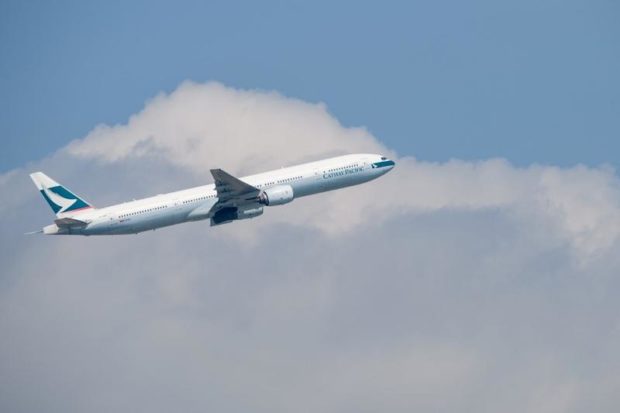
A Cathay Pacific passenger jet takes off in Hong Kong on Oct 22, 2018. AFP via China Daily/Asia News Network
HONG KONG – Hong Kong flagship carrier Cathay Pacific Airways said it had a double-digit decline in inbound forward bookings in July compared with last year amid ongoing protests in the city, though the airline rebounded to a profit in the first half.
Outbound traffic was also hit with a year-on-year single-digit percentage drop in forward bookings, while transfer traffic was affected less, Chief Customer and Commercial Officer Paul Loo told reporters when releasing the interim results on Wednesday.
The airline normally achieves better results in the second half than in the first. But uncertainties brought by the protests in Hong Kong have cast a shadow over the outlook.
Loo said the earnings peak this year may not be as good as it was in 2018 because of worries about the protests and the ongoing China-US trade tensions.
Cathay Chairman John Slosar said travelers are now taking a wait-and-see attitude before booking flights.
The carrier canceled more than 150 flights due to a general strike in the city on Monday. Many countries have warned travelers to Hong Kong to exercise a high degree of caution.
Slosar added that the company will try some promotions to win those travelers back.
Meanwhile, the escalating trade tensions have also adversely affected the company’s cargo business. Cathay, the biggest cargo airline in Asia, saw a drop of 11.4 percent in cargo services revenue in the first half.
However, total revenue rose 0.9 percent to HK$53.55 million (US$6.83 million) for the six months ended June 30, thanks to the increase in the number of passengers. The number of passengers carried saw growth of 4.4 percent, which brought the company’s passenger services revenue to HK$37.45 billion, up 5.6 percent.
First-half net income was HK$1.35 billion, compared with a year-ago loss of HK$263 million. Earnings per share reached 34.2 Hong Kong cents, compared to a loss of 6.7 HK cents per share a year before.
Lower fuel prices have helped the carrier cut cost since fuel is its most significant expense. Total fuel costs for Cathay Pacific and Cathay Dragon decreased 4.5 percent, reflecting a 6.5 percent fall in average aviation fuel prices.
Fuel hedging losses — the major factor contributing to Cathay’s poor performance in the past few years — were reduced. After taking fuel hedging into account, fuel costs decreased HK$1.21 billion, or 7.7%.
Slosar expected fuel prices to remain volatile in the future, along with a stronger US dollar.
The company completed the purchase of low-cost carrier Hong Kong Express last month. Company officials reiterated that Hong Kong Express will continue to operate as a low-cost, stand-alone company.
Hong Kong Express will also develop new destinations and expand networks, Cathay CEO Rupert Hogg said. He believes the number of middle-class passengers will increase in the next 10 to 20 years, which could benefit Hong Kong Express.
Cathay is on the last leg of a three-year transformation program to reduce costs and improve the city’s status as a transit hub.
“We are in the final year of our three-year transformation program, which is designed to make our businesses leaner, more agile and able to compete more effectively,” Slosar said. “Work on the program continues and, as evidenced by our return to profitability in 2018, we are moving in the right direction.”
Cathay shares opened 0.4 percent highr at HK$10.36 in the afternoon trading after the interim results were released. It closed 0.78 percent higher at HK$10.4 on Wednesday.